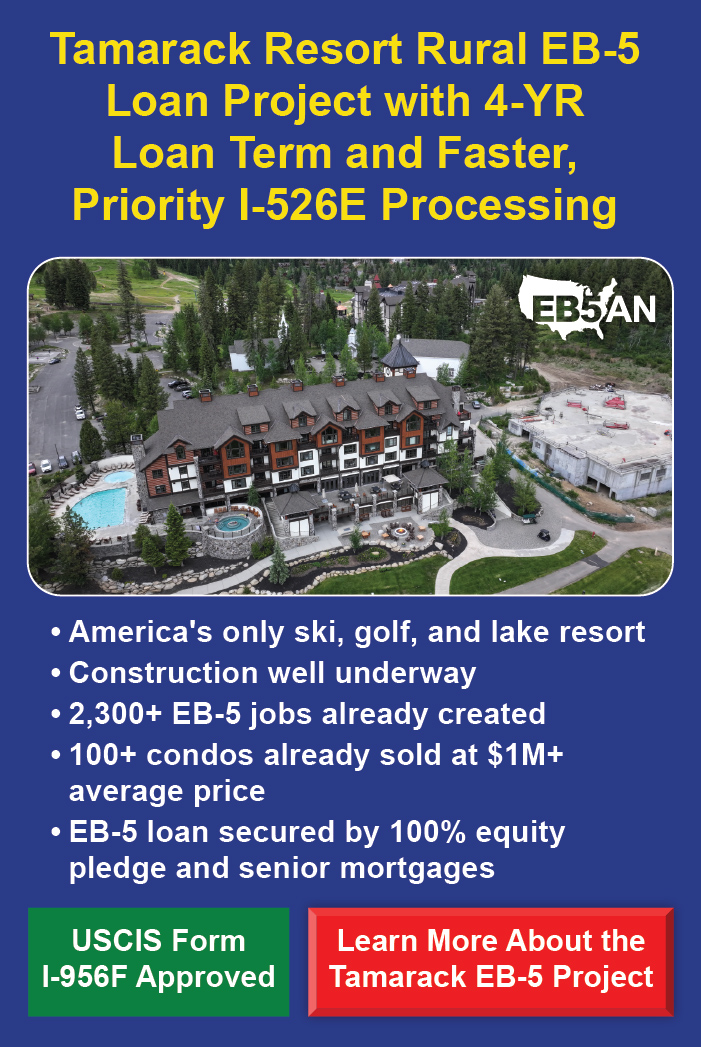The EB-5 Immigrant Investor Program has helped thousands of foreign nationals permanently relocate to the United States. Although it is considered one of the fastest and easiest ways to obtain permanent resident status, it is not always a speedy process.
EB-5 investors often face unusually long wait times during the adjudication process, with some investors from backlogged countries, like Mainland China, waiting upwards of four years.
While a four-year waiting period is not the norm, it is important for prospective investors to understand that several factors can affect the processing times for I-526 petitions. The COVID-19 pandemic, for instance, caused massive delays due to a worldwide consular shutdown and other complications.
In 2022, Congress took decisive action to help lower I-526 petition processing times and create a smoother EB-5 process for all investors. United States Citizenship and Immigration Services (USCIS) also changed the way they present their data on I-526 historical national average processing times.
This article will help investors understand these new changes to the EB-5 program, as well as how to read USCIS data on I-526 processing times.
Here’s What We’re Going to Cover:
What Is An I-526 Petition?
What Are The Factors That Can Affect The Processing Times For An I-526 Petition?
I-526 Petition Historical Average Processing Times of FY2022
A Closer Look at the Data
Incongruencies with Estimated Processing Time Ranges
How Can You Fasttrack Your I-526 Petition?
Points to Remember
What Is An I-526 Petition?
Form I-526 or I-526E is a petition to immigrate to the United States as an immigrant investor in the EB-5 Immigrant Investor Program.
Depending on the nature of their EB-5 investment, an investor and their eligible family members will fill out either Form I-526 or Form I-526E, not both.
- Form I-526, Immigrant Petition by a Standalone Investor, is for direct EB-5 investors.
- Form I-526E, Immigrant Petition by a Regional Center Investor, is for regional center EB-5 investors.
Direct investors may only count direct employees of the New Commercial Enterprise (NCE), or those working full-time under a W-2 tax form, towards their EB-5 job creation requirement.
The vast majority of EB-5 investors choose to pool their investment with other investors through an EB-5 regional center, as a regional center investment allows foreign nationals to count direct, indirect, and/or induced jobs towards their required minimum of 10 new jobs created.
An I-526 or I-526E petition requires a significant amount of supporting evidence to prove a given investment qualifies for the EB-5 program. Investors must prove the investment capital was lawfully-sourced, was actually invested in the NCE, and remains “at risk” with no guarantee of return.
The petition must also clearly demonstrate exactly how the NCE plans to use the investor’s capital to create or preserve 10 full-time jobs for U.S. workers, through widely accepted economic models, the new commercial enterprise’s business plan, and other measures.
What Are The Factors That Can Affect The Processing Times For An I-526 Petition?
An I-526 or I-526E petition can take several years for USCIS to approve, making this one of the longest stages of the EB-5 Immigrant Investor Program. Many factors can affect processing times for an investor’s I-526 petition.
Only 10,000 EB-5 immigration visas are available worldwide each year. Each country is allowed up to 7% of the total number of available visas.
If demand for EB-5 visas in a given country outstrips supply, that nation’s visa availability will become backlogged. This is known as visa retrogression.
In 2023, only Mainland China and India are backlogged. Exceptions apply for Chinese or Indian nationals who have invested in an NCE located in a targeted employment area (or TEA).
Since 2022, I-526 or I-526E petitions are now being processed based on visa availability. USCIS will prioritize petitions submitted by foreign nationals from those countries whose visa availability is listed as “C” or “current” on the Department of State’s monthly online Visa Bulletin.
I-526 Petition Historical Average Processing Times of FY2022
In FY2022, USCIS estimated that the median processing time for I-526 petitions was 44.2 months.
This means it took the USCIS about three and a half years to adjudicate at least 50% of all I-526 cases in FY2022.
This median number also means that half of all I-526 cases were processed in less than 44 months in FY2022. A less than three-year wait for I-526 adjudication is the norm for many EB-5 investors.
The USCIS historic processing times data for FY2022 reflects data from October 1, 2021 to September 30, 2022.
A Closer Look at the Data
The COVID-19 pandemic had a devastating impact on the EB-5 program. Due to the pandemic, the United States temporarily closed all U.S. embassies and consulates, effectively halting consular processing. This left thousands of EB-5 investors unable to complete their visa applications and interviews so that they could receive conditional permanent resident status.
The consular shutdown caused I-526 processing times to skyrocket beginning in FY2020. In FY2019, the median processing time for I-526 petitions was only 19 months. Just one year later, the median processing time had ballooned to 31.1 months, due to the pandemic.
On March 15th, 2022, President Biden signed the EB-5 Reform and Integrity Act into law. This law provided many welcome changes to the EB-5 program and is the most sweeping Congressional attempt to date to combat rapidly increasing EB-5 processing times.
The bill formally restarted the EB-5 Regional Center Program and required all existing regional centers to reapply under more stringent regulations. This additional delay caused a temporary spike in processing times in 2022.
Data from the first half of FY2023 suggests that I-526 and I-526E processing times will likely remain high for the rest of the fiscal year, with the median processing time crossing 50 months in March 2023.
However, as the USCIS reapproves more and more EB-5 regional centers, including EB5AN’s nationwide network of more than 20 regional centers, I-526 USCIS processing times are expected to decrease in the coming years.
Incongruencies with Estimated Processing Time Ranges
USCIS publishes both current and historic estimated processing times on its website, with data stretching back ten fiscal years. Investors must pay close attention to understand what these processing times mean, especially if they are from a backlogged country.
When searching for current estimated processing times for a given USCIS petition, such as Form I-526, the USCIS posts the time it took to process 80% of applications in the last six months.
When searching for historic estimated processing times, the USCIS posts median processing times for each fiscal year, or how long it took them to process 50% of applications that year.
Investors who don’t realize that the USCIS posts two different metrics— 80% for current processing times, 50% for historic—may falsely believe that current rates have skyrocketed over the last fiscal year.
The USCIS also posts separate current estimated processing times for foreign nationals from Mainland China and India. This is because, as of 2023, these countries are backlogged and thus face longer waits for I-526 adjudication than investors from other countries.
As of April 2023, 80% of I-526 petitions from Mainland Chinese nationals were adjudicated in 79 months or less. 80% of I-526 petitions for Indian investors were adjudicated in 52 months or less.
How Can You Fasttrack Your I-526 Petition?
The EB-5 Reform and Integrity Act now allows for expedited EB-5 processing in certain cases.
If an EB-5 project receives expedited processing designation from USCIS, investors need only wait about four to eight months for I-526 or I-526E adjudication, as opposed to two years or more.
U.S. government interests
- Cases deemed urgent by U.S. government agencies such as labor and employment agencies, and public safety or national security interests. The national interest must be immediate and substantive.
- Examples include urgent housing for natural disaster victims or an addiction treatment center.
- Expedite requests must be made by the senior government official of a given U.S. government agency (federal, state, local).
Emergencies and urgent humanitarian concerns
- Examples include the need to expedite employment authorization during a pandemic or disaster, as well as disability, extreme living conditions, and more.
Severe financial loss to a company or person
- The urgent action of an expedited request cannot be the result of an applicant’s failure to file or respond to a request in a timely manner.
- Examples include inability to travel for work that would result in job loss, or if a gap in a doctor’s employment authorization that would cause severe financial loss to a medical office.
Nonprofit organization advancing urgent U.S. cultural or social interests
- Examples include a professor, doctor, or religious leader urgently needed for immediate research, field work, or another socially impactful project. A general shortage will not suffice.
Clear USCIS error
Expedited projects are very rare. They may pose a greater financial risk. Investors should always consult with an EB-5 immigration professional and an immigration lawyer before investing in any prospective EB-5 project, and perform careful due diligence on any new commercial enterprise.
Expedited processing does not make more EB-5 visas available. Investors from countries experiencing visa retrogression will still have to wait until more green cards become available, even if their I-526 or I-526E petition has been approved.
Set-Aside Visa Categories for Visa Retrogressed Countries
For investors from Mainland China and India, the EB-5 Reform and Integrity Act has set aside visa categories for projects located in targeted employment areas (TEAs).
Targeted employment areas are geographic areas of the United States that are either rural or experiencing high unemployment of 150% above the national average. Certain infrastructure projects also qualify. EB-5 projects located in TEAs allow for a lower minimum investment of $800,000, in order to encourage greater economic development in underserved communities.
As of April 2023, the reserved visa categories for TEA projects are listed as “current” in the State Department’s monthly Visa Bulletin for all investors, including Mainland Chinese and Indian nationals. “Current” status on the monthly Visa Bulletin means that the category is not experiencing visa retrogression.
Investors from Mainland China or India who invested in a TEA project are eligible for a conditional permanent resident green card after receiving I-526 or I-526E approval, so long as the TEA reserved visa categories say “current” in the monthly Visa Bulletin.
Points to Remember
The EB-5 Immigrant Investor Program is one of the fastest ways for foreign nationals and their children to all receive permanent resident status green cards in the United States.
While I-526 historical national average processing times have climbed in recent years, Congress has taken swift action to return EB-5 processing times to their pre-pandemic levels of efficiency.
I-526 national average processing times will likely begin to decrease in the coming fiscal years. It may be the perfect time for prospective applicants to begin their EB-5 journey.
Working with an immigration attorney familiar with EB-5 immigration law is essential for an alien entrepreneur to properly submit all EB-5 petitions to United States Citizenship and Immigration Services.
EB-5 professionals like EB5AN can guide investors towards the right new commercial enterprise and help protect their capital investment.
For more information about how to speed up your I-526 processing time, or where to begin, reach out to EB5AN today.









